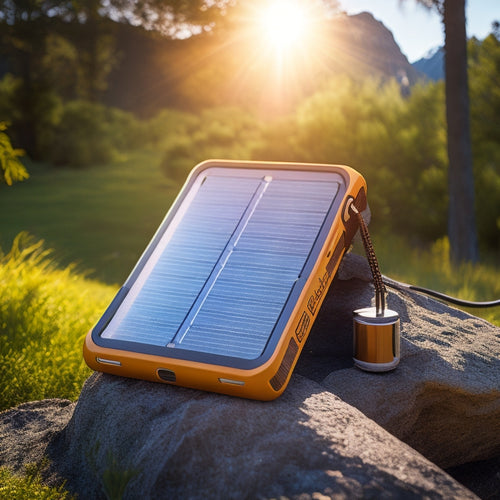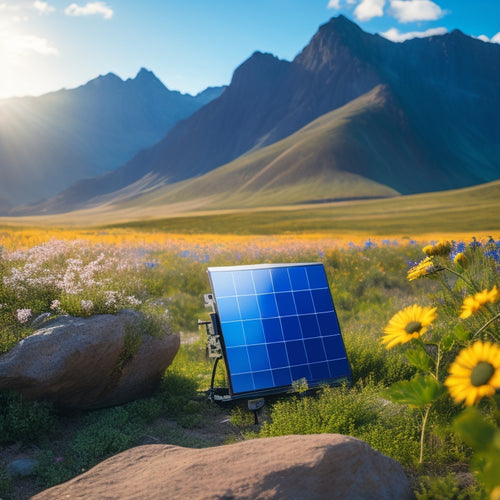
Solar Power and Battery Storage
Share
You're integrating solar power and battery storage to greatly reduce your reliance on the grid, clearing the path for a sustainable future with minimal carbon footprint. This eco-friendly approach reduces greenhouse gas emissions and promotes energy independence, leading to potential cost savings. By understanding your daily energy consumption patterns, you can optimize your energy usage and identify opportunities for efficiency upgrades. Inverters convert DC power from solar panels to usable AC power, ensuring reliable energy transfer. As you explore the world of solar power and battery storage, you'll uncover more strategies to minimize your carbon footprint and maximize your energy savings - and it all starts with a deeper understanding of your energy needs.
The Essentials
- Solar power and battery storage systems enable a zero-carbon footprint, reducing greenhouse gas emissions and promoting a sustainable lifestyle.
- Energy storage systems ensure a reliable supply of clean power, supporting eco-friendly initiatives and benefiting communities.
- Inverters efficiently convert DC power from solar panels to usable AC power, maximizing energy savings and reducing energy losses.
- Assessing daily energy consumption is crucial for system sizing, and tracking energy usage patterns aids in optimizing consumption and reducing energy waste.
- Peak power reduction strategies alleviate grid pressure during high demand, and identifying high energy usage periods helps in mitigation strategies.
Zero Carbon Footprint Guaranteed
You can achieve carbon neutral living today by incorporating solar power and battery storage into your energy strategy.
This eco-friendly approach guarantees that your energy consumption doesn't contribute to greenhouse gas emissions, allowing you to markedly reduce your carbon footprint.
By utilizing these solutions, you can assure a zero-carbon footprint and play a crucial role in mitigating climate change.
With the help of off-grid solar power systems renewable energy solutions, you can break free from traditional grid-based energy and tap into the power of the sun for your homes or businesses, guaranteeing a reliable and self-sufficient energy supply.
Carbon Neutral Living Today
Achieving carbon neutral living today is a complex challenge that necessitates a vital change of our daily habits and energy consumption patterns. You must re-evaluate your choices and prioritize a sustainable lifestyle that's in harmony with the environment. This means embracing renewable resources and reducing your reliance on fossil fuels.
By incorporating solar energy systems and battery storage solutions into your daily life, you can alleviate the burden of high energy bills and reduce grid dependence, providing you with greater energy independence and potential cost savings. renewable energy storage
To begin, you'll need to assess your energy consumption patterns. Identify areas where you can make adjustments, such as switching to energy-efficient appliances or insulating your home.
You can also reduce your energy consumption by adopting simple habits like turning off lights and electronics when not in use.
Next, consider investing in renewable energy sources like solar power or wind energy. These clean energy sources can greatly reduce your carbon footprint and provide you with a sense of freedom from the grid.
Eco-Friendly Energy Solutions
Several eco-friendly energy solutions are available to guarantee a zero-carbon footprint. You can utilize the power of renewable technology, such as solar advancements, to reduce your environmental impact. By adopting sustainable practices, you'll not only minimize your carbon footprint but also contribute to a cleaner, greener future.
Investing in green innovations, like energy storage systems, enables you to store excess energy generated by your solar panels, ensuring a reliable supply of clean power. This means you can enjoy energy independence, free from the constraints of traditional fossil fuels.
Furthermore, you'll be supporting eco initiatives that prioritize community benefits, promoting a healthier environment for generations to come. By investing in these innovative technologies, homeowners can tackle three major concerns at once, including reducing electricity bills and providing backup power during outages and emergencies.
As you shift to clean alternatives, you'll be part of a larger movement driving future solutions. By choosing eco-friendly energy solutions, you're not only reducing your carbon footprint but also creating a path for a sustainable tomorrow.
With the latest solar advancements and energy storage technologies, you can achieve a zero-carbon footprint, securing a brighter, more sustainable future for yourself and your community.
Low Energy Bills Guaranteed
You'll greatly reduce your energy expenses by utilizing solar power and storing excess energy in batteries, which is essential for achieving energy efficiency in eco-friendly homes.
By integrating renewable energy systems, such as photovoltaic cells, into your roof installation residential solar panels, you'll maximize your energy savings.
This means you'll cut your energy costs and save money on your utility bills.
Cutting Energy Costs
By integrating solar power and battery storage into your energy system, you're positioned to reap significant savings on your energy bills, effectively cutting your costs and guaranteeing low energy bills. This is made possible by utilizing the power of renewable energy and optimizing your energy usage.
With solar power, you can generate electricity during the day and store excess energy in your battery storage system for later use. This approach enables you to reduce your reliance on the grid, thereby decreasing your energy costs.
Moreover, you can benefit from renewable incentives, such as tax credits and rebates, which can help offset the initial investment costs of installing solar power and battery storage systems.
By increasing energy efficiency and reducing your energy consumption, you'll not only save money but also contribute to a more sustainable future.
Saving You Money
Saving You Money (Low Energy Bills Guaranteed)
With solar power and battery storage integrated into your energy system, low energy bills are guaranteed, and you're set to reap the financial benefits of reduced energy consumption. By utilizing the power of the sun and storing excess energy for later use, you'll considerably reduce your reliance on the grid and lower your energy bills.
This means you'll have more money in your pocket each month to allocate towards your priorities.
Additionally, you'll benefit from tax incentives designed to encourage the adoption of renewable energy sources. These incentives can help offset the initial investment in your solar power and battery storage system, making it even more financially appealing.
By achieving energy independence, you'll break free from the constraints of traditional energy providers and enjoy greater control over your energy usage.
With solar power and battery storage, you'll be saving money while also reducing your carbon footprint and contributing to a more sustainable future.
Inverter Converts DC Power
You'll need an inverter to convert the DC power generated by your solar panels or stored in your batteries into AC power, which is usable in your home.
This conversion is essential for efficient energy transfer, as most appliances and devices require AC power to function.
In fact, a well-designed home solar power storage system can provide a reliable source of energy and reduce your reliance on the grid.
DC Power Conversion
When it comes to utilizing the energy generated by solar panels, DC power conversion plays a fundamental role in making it usable for your home or business. The energy generated by solar panels is in the form of direct current (DC) power, which isn't compatible with the alternating current (AC) power used by most homes and businesses. This is where DC power conversion comes in - it enables the efficient conversion of DC power into AC power.
In DC power conversion, an inverter is used to convert the DC power into AC power. This process involves several stages, including maximum power point tracking (MPPT), DC-DC conversion, and AC-DC conversion.
The MPPT stage guarantees that the maximum amount of power is extracted from the solar panels, while the DC-DC conversion stage adjusts the voltage to match the AC grid requirements. Finally, the AC-DC conversion stage converts the DC power into AC power.
DC power conversion is vital for renewable integration, as it enables the efficient integration of DC applications, such as solar panels, into the AC grid.
With DC power conversion, you can enjoy the benefits of renewable energy while guaranteeing a stable and efficient power supply for your home or business.
Efficient Energy Transfer
The inverter plays an essential role in efficient energy transfer by converting DC power from the solar panels into usable AC power for your home or business. This conversion is vital, as AC power is what most appliances and devices require to function.
The inverter's ability to efficiently transfer energy guarantees that you can maximize the benefits of your solar power system.
When selecting an inverter, you'll want to evaluate its energy efficiency rating. A higher rating indicates that the inverter can convert more of the DC power into usable AC power, minimizing energy losses.
This is particularly important when integrating renewable energy sources into your system, as energy efficiency is key to optimizing your overall energy output.
In addition to energy efficiency, the inverter's ability to facilitate seamless renewable integration is essential.
Assess Your Energy Usage
You need to determine your daily energy consumption to accurately size your solar power system and battery storage.
This involves understanding your energy usage patterns, including the time of day and duration of your energy usage.
With the help of home energy management systems, you can gain useful perspectives into your energy usage and identify opportunities to optimize your consumption.
Daily Energy Consumption
How much energy do you actually consume daily? Understanding your daily energy consumption is essential in determining the size of the solar power system and battery storage you need to achieve energy independence.
Take a closer look at your energy habits and consumption trends to get a better grasp of your daily energy usage. Start by tracking your energy consumption over a period of time, ideally a year, to identify patterns and peak usage hours.
You can do this by monitoring your utility bills, installing smart meters, or using energy monitoring apps. This will help you identify the times of day when you consume the most energy and the appliances that use the most power.
Energy Usage Patterns
Tracking your daily energy consumption patterns reveals significant understandings into your energy usage habits, pinpointing areas where you can optimize your energy expenditure. By monitoring your energy consumption trends, you'll identify times of peak usage, when you're wasting energy, and opportunities to make adjustments. This awareness is vital in reducing your reliance on the grid and maximizing your solar power output.
You'll uncover behavioral energy habits, such as leaving lights or appliances on unnecessarily, and identify opportunities to replace energy-intensive devices with more efficient alternatives.
Evaluating your energy usage patterns will also help you determine the ideal battery storage capacity for your needs, ensuring you have a reliable backup during periods of low solar production. By understanding your energy usage patterns, you'll be able to make informed decisions about your energy setup, reducing your energy bills and environmental footprint.
With this knowledge, you'll be well on your way to achieving energy independence and enjoying the freedom that comes with it.
Higher Capacity Peak Shaving
You'll want to focus on peak power reduction to optimize your higher capacity peak shaving strategy.
This involves identifying and mitigating the highest energy usage periods, which can greatly impact your overall energy costs.
Peak Power Reduction
As solar power generation reaches its peak during the day, the strain on the grid increases, and utilities face the challenge of meeting this heightened demand.
You can help alleviate this pressure by implementing peak power reduction strategies. This approach involves reducing your energy consumption during peak hours, typically between 11 am and 5 pm, when solar power generation is at its highest.
Frequently Asked Questions
Can I Use Solar Power During a Grid Outage?
When the grid goes down, you can't rely on traditional solar systems, but you can use off-grid systems with backup power to keep the lights on, giving you freedom from grid dependence during outages.
Are Solar Panels Compatible With My Roof Type?
As you gaze up at your roof, envision a canvas awaiting a masterpiece - solar panels. You're wondering if they'll harmonize with your roof type. The answer lies in the roof materials and installation considerations; ensuring a seamless marriage between the two is essential for a successful setup.
How Long Does a Solar Battery Last?
You're wondering how long a battery lasts; its lifespan depends on charging cycles. Typically, a battery can handle 3,000 to 5,000 cycles, translating to 10 to 15 years of service, but this varies depending on usage and manufacturer.
Can I Add More Solar Panels to My System Later?
You can expand your existing setup; system expansion is possible with careful installation considerations, ensuring compatibility and peak performance, so you're free to add more panels as your energy needs evolve, without worrying about voiding warranties.
Are Solar Panels Resistant to Extreme Weather?
You'll be relieved to know that solar panels are designed to withstand extreme weather conditions, boasting impressive durability and resilience in the face of heavy rain, hail, and high winds, ensuring your energy independence remains uninterrupted.
Final Thoughts
With solar power and battery storage, you're in the driver's seat, steering towards a sustainable future. Your carbon footprint is reduced to zero, and energy bills are a thing of the past. The inverter seamlessly converts DC power, and evaluating your energy usage is a breeze. Peak shaving capabilities mean you'll never be caught off guard. By utilizing the sun's energy, you're not just powering your home - you're illuminating a cleaner tomorrow, one ray at a time.
Related Posts
-

Fastest Solar Chargers for Emergency Power
When choosing the fastest solar chargers for emergency power, you need to focus on features like rapid charging capab...
-

High-Efficiency Solar Battery Chargers for Remote Areas
High-efficiency solar battery chargers are essential for your off-grid energy needs in remote areas. They maximize en...
-

Top Solar Powered Camping Fans for Camping Enthusiasts
If you're a camping enthusiast, a solar-powered fan can be a transformative element for your outdoor experience. Thes...


